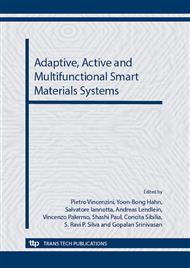p.124
p.132
p.138
p.146
p.153
p.159
p.165
p.172
p.178
Optimization of a Pyrolysis Procedure for Obtaining SiC-SiCf CMC by PIP for Thermostructural Applications
Abstract:
Polymer Impregnation Pyrolysis (PIP) is a cost effective technique for obtaining Ceramic Matrix Composites (CMC) modified with nanoparticles. Commercial UBE polymeric precursor (Tyranno polymer VL-100, diluted in xylene) of a SiC ceramic matrix (with 11 wt% O and 2 wt% Ti) was used to infiltrate 100x85x3 mmSuperscript text3 SiC felts (Tyranno ZM fibers, diameter 14 microns, 800 filament/yarn, 270 g/mSuperscript text2, with 9 wt% O and 1 wt% Zr), applying different pyrolysis procedures. In particular, pyrolysis was performed in two conditions: 1) at 1000 °C for 60 min; 2) at 900 °C for 120 min. A pyrolysis at 900 °C could be more convenient since it can be easily performed in a steel furnace, without a refractory lining. The SiC felts were pretreated by CVD (Chemical Vapour Deposition) in order to deposit a pyrolytic carbon interphase (about 0.1 microns). Impregnation was performed under vacuum, and drying was carried out in an explosion-proof heating oven. Pyrolysis at 900°C was performed in a AISI 310S austenitic steel furnace, under nitrogen flow. Geometric density was monitored during densification. Mechanical characterisation (bending tests at room temperature, following UNI EN 658-3:2002) was performed after 11 PIP cycles. The results were used to compare the influence of pyrolysis temperature on densification.
Info:
Periodical:
Pages:
153-158
Citation:
Online since:
September 2012
Price:
Сopyright:
© 2013 Trans Tech Publications Ltd. All Rights Reserved
Share:
Citation:


